Supermicro H12SSW-NT, H12SSW-IN User Manual

H12SSW-iN H12SSW-NT
USER’S MANUAL
Revision 1.0

The information in this User’s Manual has been carefully reviewed and is believed to be accurate. The vendor assumes no responsibility for any inaccuracies that may be contained in this document, and makes no commitment to update or to keep current the information in this manual, or to notify any person or organization of the updates. Please Note:
For the most up-to-date version of this manual, please see our website at www.supermicro.com.
Super Micro Computer, Inc. ("Supermicro") reserves the right to make changes to the product described in this manual at any time and without notice. This product, including software and documentation, is the property of Supermicro and/ or its licensors, and is supplied only under a license. Any use or reproduction of this product is not allowed, except as expressly permitted by the terms of said license.
IN NO EVENT WILL Super Micro Computer, Inc. BE LIABLE FOR DIRECT, INDIRECT, SPECIAL, INCIDENTAL, SPECULATIVE OR CONSEQUENTIAL DAMAGES ARISING FROM THE USE OR INABILITY TO USE THIS PRODUCT OR DOCUMENTATION, EVEN IF ADVISED OF THE POSSIBILITY OF SUCH DAMAGES. IN PARTICULAR, SUPER MICRO COMPUTER, INC. SHALL NOT HAVE LIABILITY FOR ANY HARDWARE, SOFTWARE, OR DATA STORED OR USED WITH THE PRODUCT, INCLUDING THE COSTS OF REPAIRING, REPLACING, INTEGRATING, INSTALLING OR RECOVERING SUCH HARDWARE, SOFTWARE, OR DATA.
Any disputes arising between manufacturer and customer shall be governed by the laws of Santa Clara County in the State of California, USA. The State of California, County of Santa Clara shall be the exclusive venue for the resolution of any such disputes. Supermicro's total liability for all claims will not exceed the price paid for the hardware product.
FCC Statement: This equipment has been tested and found to comply with the limits for a Class A digital device pursuant to Part 15 of the FCC Rules. These limits are designed to provide reasonable protection against harmful interference when the equipment is operated in a commercial environment. This equipment generates, uses, and can radiate radio frequency energy and, if not installed and used in accordance with the manufacturer’s instruction manual, may cause harmful interference with radio communications. Operation of this equipment in a residential area is likely to cause harmful interference, in which case you will be required to correct the interference at your own expense.
California Best Management Practices Regulations for Perchlorate Materials: This Perchlorate warning applies only to products containing CR (Manganese Dioxide) Lithium coin cells. “Perchlorate Material-special handling may apply. See www.dtsc.ca.gov/hazardouswaste/perchlorate”.
WARNING: This product can expose you to chemicals including
!lead, known to the State of California to cause cancer and birth defects or other reproductive harm. For more information, go to www.P65Warnings.ca.gov.
The products sold by Supermicro are not intended for and will not be used in life support systems, medical equipment, nuclear facilities or systems, aircraft, aircraft devices, aircraft/emergency communication devices or other critical systems whose failure to perform be reasonably expected to result in significant injury or loss of life or catastrophic property damage. Accordingly, Supermicro disclaims any and all liability, and should buyer use or sell such products for use in such ultra-hazardous applications, it does so entirely at its own risk. Furthermore, buyer agrees to fully indemnify, defend and hold Supermicro harmless for and against any and all claims, demands, actions, litigation, and proceedings of any kind arising out of or related to such ultra-hazardous use or sale.
Manual Revision 1.0
Release Date: June 27, 2019
Unless you request and receive written permission from Super Micro Computer, Inc., you may not copy any part of this document. Information in this document is subject to change without notice. Other products and companies referred to herein are trademarks or registered trademarks of their respective companies or mark holders.
Copyright © 2019 by Super Micro Computer, Inc.
All rights reserved.
Printed in the United States of America

Preface
Preface
About This Manual
This manual is written for system integrators, IT technicians and knowledgeable end users. It provides information for the installation and use of the H12SSW-iN/NT motherboard.
About This Motherboard
Built upon the functionality and capability of the AMD EPYC® 7002 series processor, the H12SSW-iN/NT motherboard provides a high performance, expandable solution while consuming little power. Please note that this motherboard is intended to be installed and serviced by professional technicians only. For processor/memory updates, please refer to our website at http://www.supermicro.com/products/.
Conventions Used in the Manual
Special attention should be given to the following symbols for proper installation and to prevent damage done to the components or injury to yourself:
Warning! Indicates important information given to prevent equipment/property damage or personal injury.
 Warning! Indicates high voltage may be encountered when performing a procedure.
Warning! Indicates high voltage may be encountered when performing a procedure.
3

H12SSW-iN/NT Motherboard User's Manual
Contacting Supermicro
Headquarters |
|
Address: |
Super Micro Computer, Inc. |
|
980 Rock Ave. |
|
San Jose, CA 95131 U.S.A. |
Tel: |
+1 (408) 503-8000 |
Fax: |
+1 (408) 503-8008 |
Email: |
marketing@supermicro.com (General Information) |
|
support@supermicro.com (Technical Support) |
Website: |
www.supermicro.com |
Europe |
|
Address: |
Super Micro Computer B.V. |
|
Het Sterrenbeeld 28, 5215 ML |
|
's-Hertogenbosch, The Netherlands |
Tel: |
+31 (0) 73-6400390 |
Fax: |
+31 (0) 73-6416525 |
Email: |
sales@supermicro.nl (General Information) |
|
support@supermicro.nl (Technical Support) |
|
rma@supermicro.nl (Customer Support) |
Website: |
www.supermicro.nl |
Asia-Pacific |
|
Address: |
Super Micro Computer, Inc. |
|
3F, No. 150, Jian 1st Rd. |
|
Zhonghe Dist., New Taipei City 235 |
|
Taiwan (R.O.C) |
Tel: |
+886-(2) 8226-3990 |
Fax: |
+886-(2) 8226-3992 |
Email: |
support@supermicro.com.tw |
Website: |
www.supermicro.com.tw |
4

Preface
|
Table of Contents |
|
Chapter 1 Introduction |
|
|
1.1 |
Checklist................................................................................................................................ |
8 |
1.1 |
Quick Reference................................................................................................................. |
11 |
|
Quick Reference Table...................................................................................................... |
12 |
|
Motherboard Features....................................................................................................... |
14 |
1.2 |
Processor and Chipset Overview....................................................................................... |
17 |
1.3 |
Special Features................................................................................................................. |
17 |
|
Recovery from AC Power Loss......................................................................................... |
17 |
1.4 |
System Health Monitoring................................................................................................... |
17 |
|
Onboard Voltage Monitors................................................................................................. |
18 |
|
Fan Status Monitor with Firmware Control........................................................................ |
18 |
|
Environmental Temperature Control.................................................................................. |
18 |
|
System Resource Alert...................................................................................................... |
18 |
1.5 |
ACPI Features.................................................................................................................... |
18 |
1.6 |
Power Supply...................................................................................................................... |
19 |
1.7 |
Super I/O............................................................................................................................. |
19 |
Chapter 2 Installation |
|
|
2.1 |
Static-Sensitive Devices..................................................................................................... |
20 |
|
Precautions........................................................................................................................ |
20 |
|
Unpacking.......................................................................................................................... |
20 |
2.2 |
Motherboard Installation..................................................................................................... |
21 |
|
Location of Mounting Holes............................................................................................... |
21 |
|
Installing the Motherboard................................................................................................. |
23 |
2.3 |
Processor and Heatsink Installation................................................................................... |
24 |
2.4 |
Memory Support and Installation........................................................................................ |
31 |
|
Memory Support............................................................................................................. |
31 |
|
DIMM Module Population.................................................................................................. |
32 |
|
DIMM Installation............................................................................................................... |
33 |
|
DIMM Removal.................................................................................................................. |
33 |
2.5 |
Rear I/O Ports..................................................................................................................... |
34 |
2.6 |
Front Control Panel............................................................................................................ |
36 |
5

H12SSW-iN/NT Motherboard User's Manual
|
Front Control Panel Pin Definitions................................................................................... |
37 |
2.7 |
Connectors.......................................................................................................................... |
40 |
2.8 |
Jumper Settings.................................................................................................................. |
45 |
|
How Jumpers Work........................................................................................................... |
45 |
2.9 |
LED Indicators.................................................................................................................... |
47 |
Chapter 3 Troubleshooting |
|
|
3.1 |
Troubleshooting Procedures............................................................................................... |
49 |
|
Before Power On............................................................................................................... |
49 |
|
No Power........................................................................................................................... |
49 |
|
No Video............................................................................................................................ |
50 |
|
System Boot Failure.......................................................................................................... |
50 |
|
Memory Errors................................................................................................................... |
50 |
|
When the System Keeps Losing its Setup Configuration................................................. |
50 |
|
When the System Becomes Unstable............................................................................... |
51 |
3.2 |
Technical Support Procedures............................................................................................ |
52 |
3.3 |
Frequently Asked Questions............................................................................................... |
53 |
3.4 |
Returning Merchandise for Service.................................................................................... |
55 |
|
Battery Removal................................................................................................................ |
56 |
|
Proper Battery Disposal..................................................................................................... |
56 |
|
Battery Installation............................................................................................................. |
56 |
Chapter 4 UEFI BIOS |
|
|
4.1 |
Introduction......................................................................................................................... |
57 |
|
Starting the Setup Utility.................................................................................................... |
57 |
4.2 |
Main Setup.......................................................................................................................... |
58 |
4.3 |
Advanced............................................................................................................................ |
60 |
4.4 |
IPMI..................................................................................................................................... |
78 |
4.5 |
Event Logs.......................................................................................................................... |
81 |
4.6 |
Security............................................................................................................................... |
83 |
4.7 |
Boot..................................................................................................................................... |
86 |
4.8 |
Save & Exit......................................................................................................................... |
88 |
6

Preface
Appendix A Software Installation |
|
|
A.1 |
Installing Software Programs.............................................................................................. |
90 |
A.2 |
SuperDoctor® 5................................................................................................................... |
91 |
Appendix B Standardized Warning Statements |
|
|
B.1 |
Battery Handling.................................................................................................................. |
92 |
B.2 |
Product Disposal................................................................................................................. |
94 |
Appendix C UEFI BIOS Recovery |
|
|
C.1 Overview............................................................................................................................. |
95 |
|
C.2 Recovering the UEFI BIOS Image...................................................................................... |
95 |
|
C.3 Recovering the BIOS Block with a USB Device................................................................. |
95 |
|
7

H12SSW-iN/NT Motherboard User's Manual
Chapter 1
Introduction
Congratulations on purchasing your computer motherboard from an industry leader. Supermicro motherboards are designed to provide you with the highest standards in quality and performance.
In addition to the motherboard, several important parts that are included with the system are listed below. If anything listed is damaged or missing, please contact your retailer.
1.1 Checklist
Main Parts List
Description |
Part Number |
Quantity |
|
Supermicro motherboard-H12SSW-iN or H12SSW-NT |
MBD-H12SSW-IN-P or |
1 |
|
MBD-H12SSW-NT-P |
|||
|
|
||
Slimline SAS x8 (LA) to SATA Cable |
CBL-SAST-0813 |
2 |
Important Links
For your system to work properly, please follow the links below to download all necessary drivers/utilities and the user’s manual for your server.
•Supermicro product manuals: https://www.supermicro.com/support/manuals/
•Product drivers and utilities: https://www.supermicro.com/wftp/driver/
•Product safety info: https://www.supermicro.com/about/policies/safety_information.cfm
•If you have any questions, please contact our support team at: support@supermicro.com
This manual may be periodically updated without notice. Please check the Supermicro website for possible updates to the manual revision level.
8
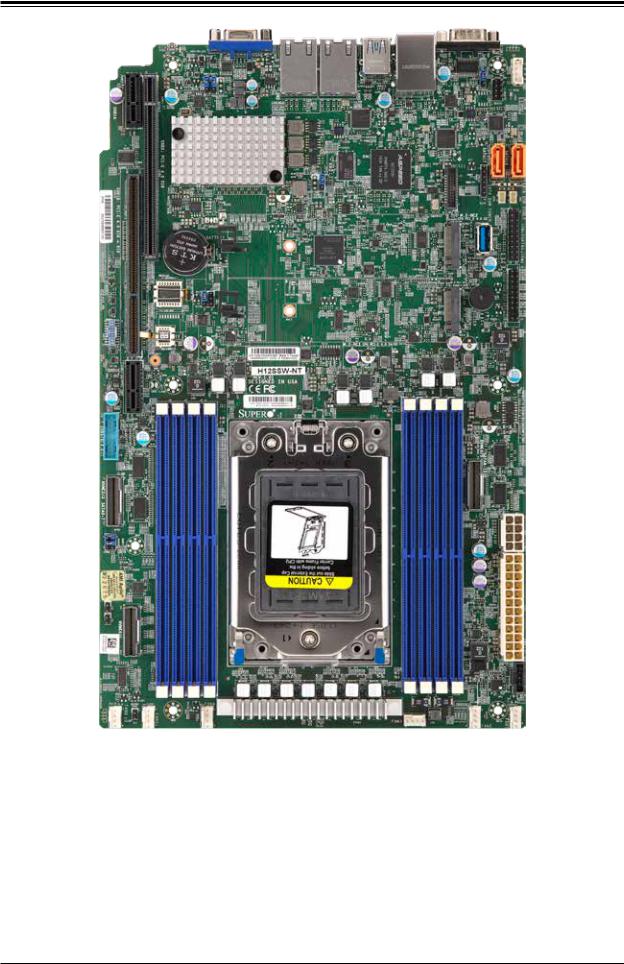
Chapter 1: Introduction
Figure 1-1. H12SSW-iN/NT Image
Note: All graphics shown in this manual were based upon the latest PCB revision available at the time of publication of the manual. The motherboard you received may or may not look exactly the same as the graphics shown in this manual.
9
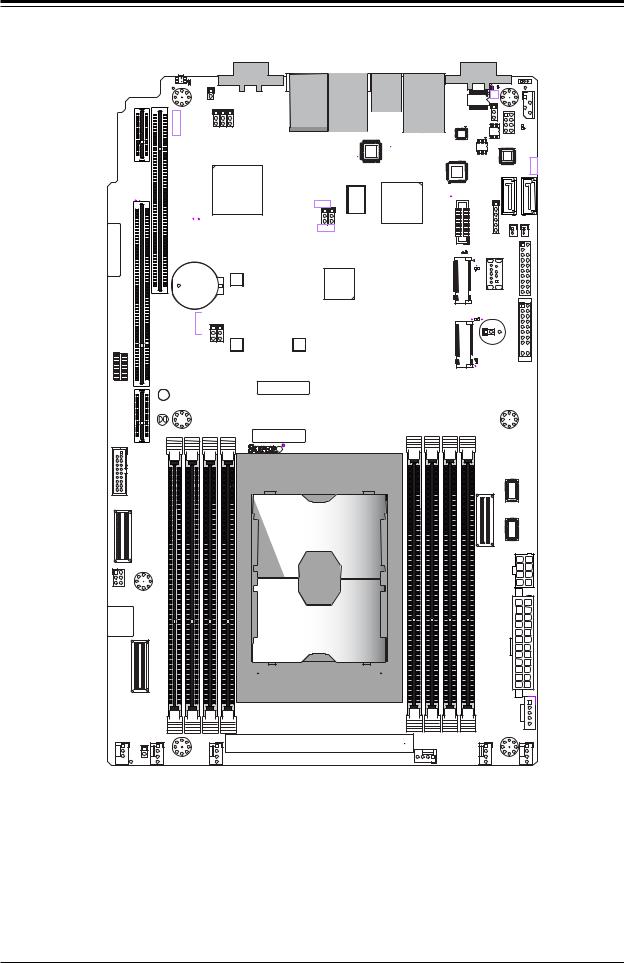
H12SSW-iN/NT Motherboard User's Manual
|
|
|
|
|
|
|
|
|
VGA |
|
|
|
|
|
|
COM1 |
JCOM1 |
|
|
|
|
|
|
||
|
|
|
|
|
|
|
|
LED1 -UID |
|
|
|
|
|
|
|
|
|
|
|
|
1 |
2 |
3 |
||
|
|
|
|
|
UID-SW |
|
|
|
USB2/3 |
USB0/1 0).(3 |
|
|
|
1 |
|
|
|
|
|
||||||
|
|
|
|
|
|
|
|
|
|
|
|
|
|
|
|
|
|
||||||||
|
|
|
|
|
|
|
|
|
|
|
(3.0) |
|
|
|
|
|
|
|
|
|
1 |
||||
|
|
|
|
|
|
|
|
|
|
|
|
|
|
|
|
|
|
|
|
|
|||||
|
|
|
|
|
JSXB2 |
|
JOH1:OH-LED |
|
|
|
|
|
|
|
|
|
|
|
|
|
|
|
3 |
||
|
|
|
|
|
|
RECOVERY 3:BIOS-2 |
|
LED |
|
LAN2 |
LAN1 |
|
|
3:DISABLE2- |
JPL1/LAN 2:ENABLE1- |
|
|
|
|
|
|
|
|
4 |
|
|
|
|
|
|
|
|
|
|
|
|
JPL1 |
|
|
2 |
|
|
|
||||||||
|
|
|
|
|
|
|
|
|
IPMI_LAN |
|
|
|
|
|
|
|
|||||||||
|
|
|
|
|
|
|
|
|
|
|
|
|
|
|
|
A |
JIPMB1 |
||||||||
|
|
|
|
|
|
|
|
|
|
|
|
|
|
|
|
|
|||||||||
|
|
|
|
|
|
|
|
|
|
|
|
|
7 |
8 |
|
C |
|||||||||
|
|
|
|
|
|
|
|
|
|
|
|
JFPGA_SW1 |
|
|
|||||||||||
|
|
|
|
|
|
|
|
|
|
|
|
|
|
|
|
|
|
||||||||
|
JSXB1ASXB1A |
JSXB1B |
|
|
E-PCI SXB2: |
JDB1 2:NORMAL1- |
JUART3 JDB1 JDB2 |
JPG1:VGA |
|
|
JUSBRJ45 |
|
|
|
|
|
SATA17 |
SUPERDOM |
|
|
LED6 |
SATA16 |
|||
|
|
|
1-2:ENABLE |
|
JNCSI1 |
|
|
|
|||||||||||||||||
|
|
|
2-3:DISABLE |
BMC |
|
|
|
||||||||||||||||||
|
|
|
|
|
|
|
|
|
|
||||||||||||||||
|
|
|
|
|
|
4 |
|
|
|
1 |
|
|
|
|
|
|
|
|
JCPLD1 |
|
|
|
|
|
|
|
|
|
|
|
|
X16 0. |
|
|
|
JPG1 |
|
|
|
|
|
|
|
|
|
|
|
|
|
||
|
4E-PCI SXB1B: |
|
|
|
|
|
|
|
JPB13 |
|
|
|
|
|
|
|
|
|
|
|
|
|
|||
|
|
|
|
|
|
|
|
|
JPB1:BMC |
|
|
|
|
|
|
|
1 |
|
|
1 |
|
JSD1 |
|||
|
|
|
|
|
|
|
|
|
|
|
|
|
|
|
|
3 |
|
|
3 |
|
|||||
|
|
|
|
|
|
|
|
|
|
|
|
|
|
|
|
|
|
|
|
|
|||||
IPMI |
|
|
|
|
CPU |
|
|
|
1-2:ENABLE |
|
|
|
|
|
|
|
JSD2 |
|
|
1 |
|
||||
|
|
|
|
|
|
|
2-3:DISABLE |
|
|
|
|
|
|
|
|
|
|
|
2 |
||||||
CODE |
. |
|
|
|
|
PORT1C |
|
|
|
|
|
|
|
LED13 |
M.2-HC2 ACT |
|
|
|
|
|
|||||
0 |
|
|
|
|
|
BT1 |
|
|
|
|
|
|
|
|
USB4(3.0) |
|
|
|
|
|
|||||
+ X16 |
|
|
|
|
|
|
|
|
|
|
|
|
|
|
|
|
|
|
|
JTPM1 |
|||||
|
|
|
|
|
|
|
|
|
|
M.2-HC2 |
|
|
LED125 |
4 |
|
|
|
|
|||||||
|
|
|
|
|
|
|
|
|
|
|
|
|
-2.M |
|
|
|
|
|
|
||||||
+ |
|
|
|
|
|
|
|
|
|
|
CPU PCI_E 4.0 X2 |
|
|
|
|
|
|
|
|
|
|||||
X16 |
|
|
|
|
BATTERY |
|
|
|
|
|
|
|
|
|
9 |
1 |
|
|
|
|
|||||
|
CPU |
|
|
|
|
|
|
|
|
|
|
|
|
|
|
ERR HC2 |
|
|
|
|
|
|
|
||
|
|
|
|
|
|
|
|
+ |
|
|
|
|
|
|
|
|
JUSBA1 |
|
|
|
|
|
|||
|
|
|
|
|
|
|
|
|
|
|
|
|
|
|
|
|
|
|
|
|
|
|
|||
|
|
|
|
|
|
|
|
|
|
|
|
|
|
|
|
|
|
|
|
1 |
|
2 |
|||
|
|
|
|
|
|
|
|
|
|
|
|
|
|
|
|
|
|
|
|
|
|
||||
PORT1A JHDT1 |
|
|
|
|
|
|
|
|
|
|
|
|
|
|
M.2-HC1 ACT |
|
|
|
|
|
|
||||
|
|
|
|
|
3:NMI-2 |
DOG JWD1:WATCH 2:RST-1 |
|
|
|
|
|
|
|
|
LED10 |
|
|
|
|
|
|
||||
|
|
|
|
|
MH4 |
|
|
CPU PCI-E 4.0 X4/X2 |
|
|
|
+ 1 |
|
BUZZER |
|
|
|
|
|||||||
|
|
|
PORT2A CPU |
|
|
|
|
M.2-HC1 |
|
|
|
|
|
|
|
|
|||||||||
|
|
|
|
|
|
|
|
|
|
|
|
|
|
|
|
|
|||||||||
|
|
|
|
JUART2 JWD1 |
MH17 |
|
|
|
|
|
|
|
ERRHC1-2.M LED11 |
|
|
JF1 |
|||||||||
|
|
|
|
|
|
|
|
|
|
|
|
|
|
||||||||||||
|
|
|
|
|
|
|
|
|
|
|
|
|
|
|
|
||||||||||
|
|
|
|
|
MH15 |
|
|
|
BAR CODE |
|
|
|
|
|
|
|
|
|
|
|
|
|
|
|
|
JSXB1C |
|
|
|
|
JBT1 |
MH6 |
|
|
H12SSW-iN |
|
|
|
|
|
|
|
|
|
|
|
|
|
|
|
|
|
|
|
|
|
|
|
|
|
|
|
|
|
|
|
|
|
|
|
|
|
|
|
|
||
J19 |
|
|
|
|
CLEAR CMOS |
|
|
|
|
MAC CODE |
|
|
|
|
|
|
|
|
|
|
|
|
|
|
|
|
SXB1C |
|
|
|
|
|
|
|
|
|
|
|
|
|
|
|
|
|
|
|
|
|
|||
|
0).USB5/6(3 |
|
|
|
|
|
|
|
|
|
|
|
|
|
|
|
|
JSLIM3 |
NVME4/5 |
|
|
|
|
|
|
SATA0 NVME2/3 |
|
|
|
|
|
|
|
|
|
|
|
|
|
|
|
|
|
|
B1 |
|
|
|
|
|
|
|
JSLIM2 |
|
|
|
|
|
|
|
|
|
|
|
|
|
|
|
|
15-SATA8 |
|
|
|
|
|
||
|
|
|
|
|
|
|
|
|
|
|
|
|
|
|
|
|
|
|
|
|
|
|
|
||
7- |
|
|
|
|
|
|
|
|
|
|
|
|
|
|
|
|
|
|
|
JPWR1 |
|
|
|
|
|
JVRM1 |
|
MH9 |
|
|
|
|
|
|
|
|
|
|
|
|
|
|
|
|
|
|
|
|
|||
|
|
|
|
|
|
|
|
|
|
|
|
|
|
|
|
|
|
|
|
|
|
|
|||
|
|
|
|
|
|
|
|
|
|
|
|
|
|
|
|
|
|
|
|
|
|
|
|
|
|
|
|
|
|
|
|
|
|
|
|
CPU |
|
|
|
|
|
|
|
|
|
|
|
|
|
|
|
LICENSEMEGERAC |
|
|
DIMMC1 DIMMD1 |
DIMMB1 |
|
|
|
|
|
|
|
|
|
|
|
|
|
|
|
|
|
|
|
|
|
|
|
|
DIMMA1 |
|
|
|
|
|
|
|
|
|
|
|
|
|
|
|
|
|
|
|
|
||
|
|
|
|
|
|
|
|
|
|
|
|
|
|
|
|
|
|
|
|
JPWR2 |
|
|
|
|
|
|
|
|
JSLIM1 |
|
|
|
|
|
|
|
|
|
|
|
|
|
|
|
|
|
|
|
|
|
|
|
|
|
NVME0/1 |
|
|
|
|
|
|
|
|
|
|
|
|
|
|
DIMMH1 DIMMG1 DIMMF1 DIMME1 |
|
|
|
|
1 |
||
|
|
|
|
|
|
|
|
|
|
|
|
|
|
|
|
|
|
|
|
|
5 |
||||
|
|
|
|
|
|
|
|
|
FAN4 |
|
|
|
|
|
|
|
|
|
|
|
|
|
FAN1 |
|
|
|
|
FAN6 |
JL1 |
|
|
FAN5 |
MH8 |
|
|
|
FAN3 |
|
|
|
|
|
FAN2 |
|
|
|
|
|
|||
|
|
|
|
|
|
|
|
Figure 1-2. H12SSW-iN/NT Layout |
|
|
|
|
|
|
|
|
|
|
|
|
|||||
10

Chapter 1: Introduction
1.1 Quick Reference |
|
|
|
|
|
|
|
|
|
|
|
|
|
|
|
|
|
|
|
|
||||||||||
|
|
|
|
|
|
|
|
|
JOH1 |
LAN 2 |
|
USB 2/3 |
|
|
|
|
|
|
|
|
|
|
|
|
|
|
|
|
||
|
|
|
|
|
|
UID SW |
VGA |
|
|
|
|
COM1 |
|
|
|
|
|
|
|
|
||||||||||
|
|
|
|
|
|
|
LAN 1 |
USB 0/1 |
|
|
|
|
|
|
|
|
|
|
||||||||||||
|
|
|
|
|
|
VGA |
|
|
|
COM1 |
JCOM1 |
|
|
|
|
|
|
|
|
|
||||||||||
|
|
|
|
|
|
|
|
|
LED1 -UID |
|
|
|
USB0/1 0).(3 |
|
|
|
|
|
|
|
|
JPL1 |
|
|
||||||
|
|
|
|
|
|
UID-SW |
|
|
|
USB2/3 |
|
|
|
|
1 |
|
|
|
|
2 |
|
|
||||||||
|
|
|
|
|
|
|
|
|
|
|
|
|
|
|
|
|
|
|
|
|
|
|
|
|
1 |
2 |
3 |
|
|
|
|
|
|
|
|
|
|
|
|
LED |
|
LAN2 |
LAN1 |
(3.0) |
|
3:DISABLE-2 |
JPL1/LAN 2:ENABLE-1 |
|
|
|
|
|
|
|
|
|
1 |
COM2 |
|
|
|
LED 1 |
|
|
|
|
|
RECOVERY3:BIOS-2 |
|
|
|
|
|
|
|
|
|
2 |
|
|
|
4 |
|
|
||||||||
|
|
|
|
|
|
|
|
|
|
|
|
|
|
|
|
|
|
|
|
JIPMB1 |
|
|
|
|||||||
|
|
|
|
|
|
JSXB2 |
|
JOH1:OH-LED |
|
|
|
|
|
|
|
|
|
|
|
|
|
|
|
|
3 |
|
JIPMB1 |
|||
|
|
|
JSXB1ASXB1A |
|
|
|
|
JDB1 2:NORMAL1- |
JUART3 JDB1 JDB2 |
|
|
|
IPMI_LAN |
|
|
|
|
JPL1 |
|
|
|
|
A |
|
|
|||||
SXB1A |
|
|
JSXB1B |
|
|
E-PCISXB2: |
2-3:DISABLE |
BMC |
JUSBRJ45 |
|
|
|
|
|
SATA17 |
SUPERDOM |
|
|
LED6 |
SATA16 |
|
|
|
|||||||
|
|
|
|
|
|
|
|
|
|
|
|
|
IPMI LAN |
|
|
|
|
|
|
7 |
8 |
|
C |
|
|
|
|
|||
|
|
|
|
|
|
|
|
|
|
|
|
|
|
|
|
|
|
|
|
|
JFPGA_SW1 |
|
|
|
|
|
|
|||
SXB2 |
|
|
|
|
|
|
|
|
|
|
|
|
|
|
|
|
|
|
|
|
|
|
|
|
|
|
|
LED 6 |
|
|
|
|
|
|
|
|
|
|
|
|
JPG1:VGA |
|
|
|
|
|
|
|
|
|
|
|
|
|
|
|
SATA0 |
|
|
||
|
|
|
|
|
|
|
|
|
|
|
1-2:ENABLE |
|
|
|
|
|
|
|
|
|
|
|
|
|
|
|
|
|
||
|
|
|
|
|
|
|
|
|
|
|
1 |
|
|
|
JNCSI1 |
|
|
|
|
|
|
|
|
|
SATA1 |
|
|
|||
|
|
|
|
|
|
|
|
|
|
|
|
|
|
|
|
|
|
|
|
|
|
|
|
|
|
|
||||
SXB1B |
|
IPMI |
4E-PCISXB1B: |
|
|
|
X16 0.4 |
|
|
JPB1 |
JPB13 |
JPG1 |
JPG1 |
|
|
|
|
|
|
|
JCPLD1 |
JSD2 |
|
|
|
|
|
JSD1 |
|
JCPLD1 |
|
|
|
|
CPU |
|
|
|
JPB1:BMC |
|
|
|
|
|
|
|
|
|
|
|
|
|
|
||||||||
|
|
|
|
|
|
|
|
|
|
|
|
|
|
|
|
|
|
1 |
|
|
1 |
|
JSD1 |
|
|
|||||
|
|
|
|
|
|
|
|
|
|
1-2:ENABLE |
|
|
|
|
|
|
|
|
|
|
|
|
1 |
|
JSD2 |
|
|
|||
|
|
|
|
|
|
|
|
|
|
|
2-3:DISABLE |
|
|
|
|
|
|
|
|
|
3 |
|
|
3 |
|
2 |
|
|
||
|
|
|
|
|
|
|
|
|
|
|
|
|
|
|
|
|
|
|
|
|
|
|
|
|
|
|
|
|
||
|
|
CODE |
. |
|
|
|
PORT1C |
BATTERY |
|
|
|
|
LED13 |
M.2-HC2 ACT |
|
|
|
|
|
|
|
|
||||||||
|
|
0 |
|
|
|
|
T1 |
|
|
|
|
|
|
|
-2.M |
|
|
|
|
|
|
|
JTPM1 |
TPM/PORT80 |
||||||
|
|
X16 |
|
|
|
|
|
|
|
|
M.2-HC2 |
|
|
|
|
9 |
1 |
|
|
|
|
|||||||||
|
|
|
+ X16 |
|
|
|
|
|
|
|
|
|
|
|
LED125 |
4 |
|
|
|
|
|
|||||||||
|
|
|
|
|
|
|
|
|
|
|
|
M.2-C2 |
|
|
|
|
|
|
USB4(3.0) |
|
|
|
|
|
USB 4 (3.0) |
LED 12 |
||||
|
|
|
|
|
|
|
|
BATTERY + |
|
|
|
|
|
|
|
|
JUSBA1 |
|
|
|
|
|
||||||||
|
|
|
+ |
|
|
|
|
|
|
|
|
|
|
CPU PCI_E 4.0 X2 |
|
|
|
|
|
|
|
|
|
|
|
|
|
|
|
|
|
|
|
CPU |
|
|
|
|
|
|
|
|
|
|
|
|
|
|
|
ERRHC2 |
|
|
|
|
1 |
|
|
|
|
|
|
|
|
|
PORT1A |
|
|
|
|
|
|
|
|
|
|
|
|
|
|
LED10 |
|
|
|
|
|
|
2 |
|
|
|
||
|
|
JHDT1 |
|
|
|
PORT2ACPU |
|
3:NMI-2 |
DOGJWD1:WATCH 2:RST-1 |
JUART2 JWD1 |
|
|
|
|
|
|
M.2-HC1 ACT |
BUZZER |
|
|
|
|
|
|
|
|||||
|
|
|
|
|
|
|
|
M.2-C1M.2-HC1 |
|
|
|
2.M |
|
|
|
JF1 |
JF1 |
|
|
|||||||||||
|
|
|
|
|
|
|
|
|
|
MH4 |
|
|
CPU PCI-E 4.0 X4/X2 |
|
|
|
+ |
1 |
|
|
|
|
|
|
|
|
|
|
||
|
|
|
|
|
|
|
|
|
|
|
|
|
|
|
|
|
|
|
|
|
|
|
|
|
|
|
|
|
||
|
|
|
|
|
|
|
|
|
|
|
MH17 |
|
|
|
|
|
|
|
|
|
|
|
|
|
|
|
|
BUZZER |
|
|
|
|
|
|
|
|
|
|
|
|
|
|
|
|
|
|
|
|
|
|
|
|
|
|
|
|
|
|
|
|
|
|
|
|
|
|
|
JBT1 |
|
JWD1 |
|
|
|
|
|
|
|
|
ERRHC1- LED11 |
|
|
|
|
|
|
|
|
LED 11 |
||||
|
|
|
|
|
|
MH15 |
|
|
BAR CODE |
|
|
|
|
|
|
|
|
|
|
|
|
|
|
|
|
|
||||
SXB1C |
JSXB1C |
|
|
|
|
JBT1 |
MH6 |
|
H12SSW-iN |
|
|
|
|
|
|
|
|
|
|
|
|
|
|
|
|
|
|
|
||
|
|
|
|
|
|
|
|
|
|
|
|
|
|
|
|
|
|
|
|
|
|
|
|
|
|
|
|
|||
|
J19 |
|
SXB1C |
|
CLEARCMOS |
|
|
|
|
|
|
|
|
|
|
|
|
|
|
|
|
|
|
|
|
|
|
|
|
|
|
|
|
|
|
|
|
MAC CODE |
|
|
|
|
|
|
|
|
|
|
|
|
|
|
|
|
|
|
|
||||
|
|
|
|
|
|
|
|
|
|
|
|
|
|
|
|
|
|
|
|
|
|
|
|
|
|
|
|
|
||
USB 5/6 (3.0) |
|
|
0).USB5/6(3 |
|
|
|
|
|
|
|
|
|
|
|
|
|
|
|
JSLIM3 |
|
|
|
|
|
|
|
|
|
||
|
|
|
|
|
|
|
|
|
|
|
|
|
|
|
|
|
|
NVME4/5 |
|
|
|
|
|
|
|
|
||||
|
|
|
|
|
|
|
|
|
|
|
|
|
|
|
|
|
|
|
|
|
B1 |
|
|
|
|
|
NVME 4/5 |
|
||
NVME 2/3 |
|
SATA0NVME2/3 |
|
|
|
|
|
|
|
|
|
|
|
|
|
|
|
|
|
|
|
15-SATA8 |
|
|
|
|
|
SATA 8-15 |
|
|
|
|
JSLIM2 |
|
|
|
|
|
|
|
|
|
|
|
|
|
|
|
|
|
|
|
|
|
|
|
|
|
|||
SATA 0-7 |
|
7- |
|
MH9 |
|
|
|
|
|
|
|
|
|
|
|
|
|
|
|
|
JPWR1 |
|
|
|
|
|
JPWR1 |
|
||
|
|
JVRM1 |
|
|
|
|
|
|
|
|
|
|
|
|
|
|
|
|
|
|
|
|
|
|
||||||
|
|
|
|
|
|
|
|
|
|
|
CPU |
|
|
|
|
|
|
|
|
|
|
|
|
|
|
|
|
|
|
|
|
|
LICENSEMEGERAC |
|
DIMMC1 DIMMD1 |
DIMMB1 |
|
|
|
|
|
|
|
|
|
|
|
|
|
|
|
|
|
|
|
|
|
|
|
|
|
|
|
|
|
DIMMA1 |
|
|
|
|
|
|
|
|
|
|
|
|
|
|
|
|
|
|
|
|
|
|
|
|
||
|
|
|
|
JSLIM1 |
|
|
|
|
|
|
|
|
|
|
|
|
|
|
|
|
JPWR2 |
|
|
|
|
|
JPWR2 |
|
||
|
|
|
|
|
|
|
|
|
|
|
|
|
|
|
|
|
|
|
|
|
|
|
|
|
|
|
|
|
||
NVME 0/1 |
|
|
|
NVME0/1 |
|
|
|
|
|
|
|
|
|
|
|
|
|
|
DIMMH1 DIMMG1 DIMMF1 DIMME1 |
|
|
|
|
|
PWRI2C |
|||||
|
|
|
|
|
|
|
|
|
|
|
|
|
|
|
|
|
|
|
|
|
|
5 |
||||||||
|
|
|
|
|
|
|
|
|
|
|
|
|
|
|
|
|
|
|
|
|
|
|
|
|
|
|
1 |
|
|
|
FAN 6 |
|
|
|
|
|
|
|
|
|
FAN4 |
|
|
|
|
|
|
|
|
|
|
|
|
|
|
FAN1 |
|
FAN 1 |
|
||
|
|
|
FAN6 JL1 |
|
|
FAN5 |
MH8 |
|
|
|
FAN3 |
|
|
|
|
|
|
FAN2 |
|
|
|
|
|
|
||||||
|
|
|
|
|
|
|
|
|
|
|
|
|
|
|
|
|
|
|
|
|
|
|
||||||||
|
|
JL1 |
|
FAN 5 |
|
FAN 4 |
|
|
FAN 3 |
|
|
FAN 2 |
|
|
|
|
|
|
|
|
||||||||||
Notes:
•See Chapter 2 for detailed information on jumpers, I/O ports, and JF1 front panel connections.
•Jumpers/LED indicators not indicated are used for testing only.
•Use only the correct type of onboard CMOS battery as specified by the manufacturer. Do not install the onboard battery upside down to avoid possible explosion.
11

H12SSW-iN/NT Motherboard User's Manual
Quick Reference Table
Jumper |
Description |
Default Setting |
|
UID SW |
Unit ID switch (push-button toggle switch ON/OFF) |
Off |
|
JBT1 |
Clear CMOS |
Open (Normal) |
|
JWD1 |
Watch Dog Timer control |
Pins 1-2 |
(Reset) |
JPL1 |
LAN Enable/Disable (H12SSW-NT only) |
Pins 1-2 |
(Enabled) |
JPG1 |
Onboard Video Disable/Enable |
Pins 1-2 |
(Enabled) |
LED |
Description |
Status |
LED1 |
UID LED |
Blue: UID Activated |
LED6 |
Power LED |
On: Power On |
LED 7 |
BMC Heartbeat |
Blinking: BMC Normal/Working |
LED12 |
M.2-C2 Interface Detection |
On: SATA Off: PCI-E |
LED11 |
M.2-C1 Interface Detection |
On: SATA Off: PCI-E |
|
|
|
Connector |
Description |
Battery (BT1) |
Onboard CMOS battery |
COM 1, COM 2 |
Rear panel COM port #1, Header for COM port #2 |
JCPLD1 |
Complex-Programmable Logical Device (CPLD) header |
FAN 1~6 |
System cooling fan headers |
JF1 |
Front control panel |
JSD1, JSD2 |
SATA DOM power connector |
JTPM1 |
Trusted Platform Module (TPM)/Port 80 connector |
SATA0, SATA1 |
Internal SATA Ports |
JL1 |
Chassis intrusion header |
JOH1 |
Chassis overheat header |
USB 0/1 (3.0) |
Back panel USB 3.0 ports (USB 0/1) |
USB 2/3 (3.0) |
Back panel USB 3.0 ports (USB 2/3) |
USB 4 (3.0) |
USB 3.0 type A port (USB 4) |
USB 5/6 (3.0) |
Internal USB 3.0 header (USB 5/6) |
SXB1A, SXB2, SXB1C |
Riser slots |
JPWR2 |
24-pin ATX power supply connector |
JPWR1 |
12V 8-pin ATX CPU power connector |
|
|
Note: The table above is continued on the next page.
12

Chapter 1: Introduction
Connector |
Description |
M.2-C1, M.2-C2 |
M.2 Slots |
PWRI2C |
Power supply SMBus I2C header |
JIPMB1 |
4-pin External BMC I2C Header (for an IPMI Card) |
LAN1, LAN2 |
Back panel LAN1, LAN2 connectors |
VGA |
Back panel VGA port |
NVMe0~5 |
NVMe slots 0~5 |
|
|
Note: Jumpers, connectors, switches, and LED indicators that are not described in the preceding tables are for manufacturing testing purposes only, and are not covered in this manual.
13
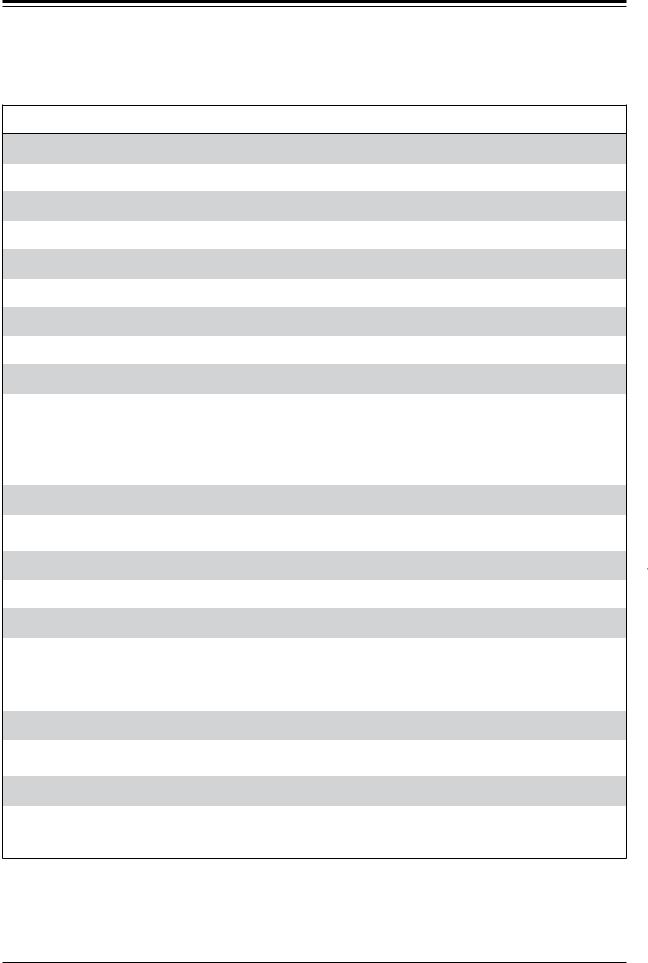
H12SSW-iN/NT Motherboard User's Manual
Motherboard Features
Features
CPU
• Single AMD EPYC® 7002 series processor, in one SP3 socket
Memory
• Up to two TB of ECC DDR4 3200 MHz speed, RDIMM/LRDIMM/3DS/NVDIMM memory in eight slots
DIMM Size
• Up to 128GB size at 1.2V
Chipset
• System on Chip
Expansion Slots
•1x PCI-E 4.0 (x32) Left Riser Slot
•1x PCI-E 4.0 (x16) Right Riser Slot
•M.2 Interface: 2x PCI-E 4.0 x2/SATA.
•M.2 Form Factor: 2280, 22110
•M.2 Key: M-Key
Network
•ATEN IPMI from ASPEED AST 2500 BMC for gigabit RJ45 port
•Two RJ45 1GbE LAN ports, H12SSW-iN(1GbE Broadcom 5720L); H12SSW-NT(10GbE Broadcom 57416)
Graphics
• ASPEED AST2500 BMC chip with one VGA port
I/O Devices
•One COM RS-232 type connector
•One COM header
•Six USB 3.0 headers
•One USB 3.0 Type A connector
Peripheral Devices
•Two native NVMe Ports (SlimSAS x8); Four internal NVMe or sixteen SATA dual use ports (SlimSAS x8)
•Two SATA DOM ports
BIOS
•128Mb SPI AMI BIOS®
•ACPI 6.2, SMBIOS 3.1.1, Plug-and-Play (PnP), BIOS rescue hot-key, RTC (Real Time Clock) wake up, Riser Card Auto-
Detection Support
Note: The table above is continued on the next page.
14

Chapter 1: Introduction
Features
Power Management
•ACPI power management (S5)
•Power button override mechanism
•Power-on mode for AC power recovery
System Health Monitoring
•Onboard voltage monitoring for +1.8V, 3.3V, +5V, +12V, +3.3V Standby, +5V Standby, VBAT, HT, Memory
•Onboard monitoring for CPU, system, and memory temperature
•CPU switching phase voltage regulator
•CPU Thermal Trip support
Fan Control
•Single cooling zone
•Low-noise fan speed control
•Pulse Width Modulation (PWM) fan control
System Management
•Trusted Platform Module (TPM) support
•System resource alert via SuperDoctor® 5
•SuperDoctor® 5, Watch Dog
•Non-Maskable Interrupt (NMI)
•SUM-InBand, SUM-OOB, IPMICFG, IPMIVIew, SMCIPMITOOL
LED Indicators
•Power State Indicator
•CPU/Overheating
•Fan Failure
•LAN activity
•UID / Remote UID
Dimensions
• 8" (L) x 13" (W), 20.32cm (L) x 33.02cm (W)
15
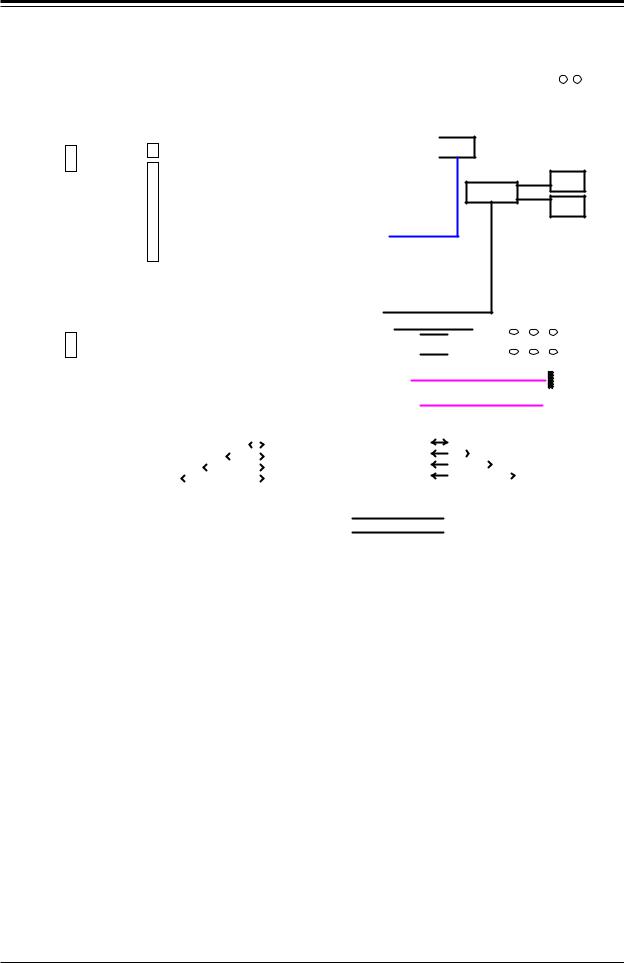
H12SSW-iN/NT Motherboard User's Manual
H12SSW AMD SP3 Rome Rev. 1.00
Rear I/O
|
|
|
|
|
|
|
|
|
|
|
|
|
|
|
|
MLAN |
|
|
|
|
|
|
|
|
|
|
|
|
+ |
|
USB3.0 X 2 |
|
|
|
|
|
|
ID LED ID SW |
|
COM1 |
|
USB3.0 X 2 |
|
|
|
LAN1 |
|
LAN2 |
|
VGA |
|
|
|
|
|
|
|
|
|
|
|
|
|
|
|
|
|
|
|
|
|
|
|
|
|
|
|
|
|
|
|
|
|
|
|
|
|
|
|
|
|
|
|
|
|
|
|
|
|
|
10Gb LAN 10Gb LAN |
|
Rear |
|
|
|
IPMI LAN |
||||||||||||||||||||
|
|
|
SXB1 |
|
|
|
|
|
SXB2 |
|
|
|
|
|
|
|
|
USB 3.0 |
|
|
|
||||||||||||||||||||||||||||
|
|
|
|
|
|
|
|
|
|
|
|
|
|
|
|
|
RJ45 |
|
RJ45 |
|
X 2 |
|
|
|
|
RJ45 |
|||||||||||||||||||||||
|
|
|
|
|
|
|
|
|
|
|
|
|
|
|
|
|
VGA |
|
|
|
|
|
|
|
|
|
|
|
|
|
|
|
|
|
|
|
|
Rear |
|
|
|
|
|
|
|
|
|
||
|
|
|
|
|
|
|
|
|
|
|
|
|
|
|
|
|
|
|
|
|
|
|
|
|
|
|
|
|
|
|
|
|
|
|
|
|
|
|
|
|
|
|
|
|
|
|
|
||
|
|
|
|
|
|
|
|
|
|
|
|
|
|
|
|
|
|
|
|
|
|
|
|
|
|
|
|
|
|
|
|
|
|
|
|
|
|
|
|
|
|
|
|
|
|||||
|
|
|
|
|
|
|
|
|
|
|
|
|
|
|
|
|
|
|
|
|
|
|
|
|
|
|
|
|
|
|
|
|
|
|
|
|
|
USB 3.0 |
|
|
|
|
|
|
|||||
RX 15-8 |
|
|
|
|
|
RX 0-7 |
|
|
|
|
|
|
|
|
|
|
|
|
|
|
|
|
|
|
|
|
|
|
|
|
|
|
|
X 2 |
|
|
|
|
|
|
|||||||||
|
|
|
|
|
|
|
|
|
|
|
|
|
|
|
|
|
|
|
|
|
|
|
|
|
|
|
|
|
|
|
|
|
|
|
|
|
|
|
|
|
|
|
|||||||
|
|
|
|
|
|
|
|
|
|
|
TX 0-15 |
|
RX 0-15 |
|
|
BCM57416 |
|
|
|
|
|
|
|
|
|
|
|
|
|
|
|
|
|
|
|
|
|
|
|
|
|
|
|||||||
|
|
|
|
|
|
|
|
|
|
|
|
|
|
|
|
|
(co-lay BCM5720L) |
|
|
|
|
|
|
|
|
|
|
ASM1042 |
|
|
ASM1042 |
|
|
||||||||||||||||
|
|
|
|
|
|
|
|
|
|
|
|
|
|
|
|
|
|
|
|
|
|
|
|
|
|
|
|||||||||||||||||||||||
TX 15-8 |
|
|
|
|
|
TX 0-7 |
|
|
|
|
|
|
|
|
|
|
|
|
|
|
|
|
|
|
|
|
|
|
|
USB controller |
|
USB controller |
|
|
|||||||||||||||
|
|
|
|
|
|
|
|
|
|
|
|
|
|
|
|
|
|
|
|
|
|
|
|
|
|
|
|
|
|
|
|
|
|
|
|
|
|
|
|
|
|
|
|
||||||
|
|
|
|
|
|
|
|
|
|
|
|
|
|
|
|
|
|
|
|
|
|
|
|
|
|
|
|
|
|
|
|
|
|
|
|
|
|
|
|
|
|
|
|
|
|
|
|
|
|
RX 0-15 |
|
|
|
|
|
TX 0-15 |
|
|
|
|
|
|
|
|
|
|
|
|
|
|
|
|
|
|
|
|
|
|
|
|
|
|
|
|
|
|
|
|
|
|
|
|
|
|
|
||||
|
|
|
|
|
|
|
|
|
|
|
|
|
|
|
|
|
|
|
|
|
|
|
|
|
|
DDR4 |
|
|
|
|
|
|
|
|
|
|
|
|
PHY |
||||||||||
|
|
|
|
|
|
|
|
|
|
|
|
|
|
|
|
|
|
|
|
|
|
|
|
|
|
|
|
|
|
|
|
|
|
|
|
||||||||||||||
|
|
|
|
|
|
|
|
|
|
|
|
|
|
|
|
|
|
|
|
|
|
|
|
|
|
|
|
|
|
|
|
|
|
|
|
|
|
|
|
|
|
|
|
||||||
|
|
|
|
|
|
|
|
|
|
|
|
|
|
|
|
|
|
|
|
|
|
|
|
|
|
|
|
|
|
|
|
|
|
|
|
|
|
|
|
|
|
|
RTL8211F |
||||||
|
|
|
|
|
|
|
|
|
|
|
|
|
|
|
|
|
|
|
|
|
|
|
|
|
|
|
|
|
|
|
|
|
|
|
|
|
|
|
BMC |
|
|
|
|||||||
|
|
|
|
|
|
|
|
|
|
|
|
|
|
|
|
|
|
|
|
|
|
|
|
|
|
|
|
|
|
|
|
|
|
|
|
|
|
|
|||||||||||
|
|
|
|
|
|
|
|
|
|
|
|
|
|
|
|
|
|
|
|
|
|
|
|
|
|
|
|
|
|
|
|
BMC ROM |
|
|
|
AST2500 |
|
|
|
||||||||||
|
|
|
|
|
|
|
|
|
|
|
|
|
|
|
|
|
|
|
|
|
|
|
|
|
|
|
|
|
|
|
|
|
|
|
|
|
|
|
|
|
|
|
|
|
|
|
|||
|
|
|
|
|
|
|
|
|
|
|
|
|
|
|
|
|
|
|
|
|
|
|
|
|
|
|
|
|
|
|
|
32MB |
|
|
|
|
|
P0 [6] |
|
|
|
|
|
|
|||||
|
|
|
|
|
|
|
|
|
|
|
|
|
|
|
|
|
|
|
|
|
|
|
|
|
|
|
|
|
|
|
|
|
|
|
|
|
|
|
|
|
|
|
|||||||
|
|
|
|
|
|
|
|
|
|
|
|
|
|
|
|
|
|
|
|
|
|
|
|
|
|
|
|
|
|
|
|
|
|
|
|
|
|
|
|
|
|
||||||||
|
|
|
|
|
|
|
|
|
|
|
|
|
|
|
|
|
|
|
|
|
|
|
|
|
|
|
|
|
|
|
|
|
|
|
|
|
|
|
|
|
|
|
|
|
|
|
|
|
|
|
|
|
|
|
|
|
|
|
|
|
|
|
|
|
|
|
|
|
|
|
|
|
|
|
|
|
|
|
|
|
|
|
|
|
|
|
SPI |
|
|
|
USB_0_HSD1 |
||||||||
|
|
|
|
|
|
|
|
|
|
|
|
|
|
|
|
|
|
|
|
|
|
|
|
|
|
|
|
|
|
|
|
|
|
|
|
|
|
|
|
||||||||||
|
|
|
|
|
|
|
|
|
|
|
|
|
|
|
|
|
|
|
|
|
|
|
|
|
|
|
|
|
|
|
|
|
|
|
|||||||||||||||
|
|
|
|
|
|
|
|
|
|
|
|
|
|
|
|
|
|
|
|
|
|
|
|
|
|
|
|
|
|
|
|
|
|
|
|
|
|
|
|
|
|
|
|
|
|
|
|
||
|
|
|
|
|
|
|
|
|
|
|
|
|
|
|
|
|
|
|
|
|
|
|
|
|
|
|
|
|
|
|
|
|
|
|
|
|
|
|
|
|
|
|
|
|
|
|
|
||
|
|
|
|
|
|
|
|
|
|
|
|
|
|
|
|
|
|
|
|
|
|
|
|
|
|
|
|
|
|
|
|
|
|
|
|
|
|
|
|
|
|
|
|
|
|
|
|
||
|
|
|
|
|
|
|
|
|
|
|
|
|
|
|
|
|
|
|
|
|
|
|
|
|
|
|
|
|
|
|
|
|
|
|
|
|
|
|
|
|
|
|
|
|
|
|
|
||
|
|
|
|
|
|
|
|
|
|
|
|
|
|
|
|
|
|
|
|
|
|
|
|
|
|
|
|
BIOS ROM |
|
MUX |
|
|
|
|
|
|
|
|
|
|
|
|
|
|
|||||
|
|
|
|
|
|
|
|
|
|
|
|
|
|
|
|
|
|
|
|
|
|
|
|
|
|
|
|
|
|
|
|
|
|
|
|
|
|
|
|
|
|
||||||||
|
|
|
|
|
|
|
|
|
|
|
|
|
|
|
|
|
|
|
|
|
|
|
|
|
|
|
|
|
|
32 MB |
|
|
|
|
|
|
|
|
|
|
|
|
|
|
|
|
|
||
|
|
|
|
|
|
|
|
|
|
|
|
|
|
|
|
|
|
|
|
|
|
|
|
|
|
|
|
|
|
|
|
|
|
SPI |
|
|
|
|
|
|
P0 [3:2] |
MUX |
|||||||
|
|
|
|
|
|
|
|
|
|
|
|
|
|
|
|
|
|
|
|
|
|
|
|
|
P0 [5] |
|
|
|
|
|
|
TPM |
|
|
|
|
|
|
|
|
|
|
|
|
|||||
|
|
|
|
|
|
|
|
|
|
|
|
|
|
|
|
|
|
|
|
|
|
|
|
|
|
|
|
|
|
|
|
|
|
|
|
|
|
|
|
|
|
|
|||||||
|
|
|
|
|
|
|
|
|
|
|
|
|
|
|
|
|
|
|
|
|
|
|
|
|
P0 [4] |
|
|
|
|
|
|
|
|
|
|
|
|
|
|
|
|
|
|
|
|
||||
|
|
|
|
|
|
|
|
|
|
|
|
|
|
|
|
|
|
|
|
|
|
|
|
|
|
|
|
|
|
|
|
|
|
|
|
|
|
|
|
|
|
||||||||
|
|
|
|
|
|
|
|
|
|
|
|
|
|
|
|
|
|
|
|
|
|
|
|
|
P0 [15:8] |
|
|
|
|
|
|
|
|
|
|
|
|
|
|
|
|
||||||||
|
|
|
|
|
|
|
|
|
|
|
P1[15:0] |
|
|
|
P2 [15:0] |
|
|
|
|
|
|
|
|
|
|
|
|
|
|
|
|
|
|
|
|
LPC |
|
|
|
|
|
|
|
|
|
|
|
||
|
|
|
|
|
|
|
|
|
|
|
|
|
|
|
|
|
|
|
|
|
|
|
|
|
|
|
|
|
|
|
|
|
|
|
|
|
|
|
|
|
|
|
|
|
|
|
|
||
|
|
|
|
|
|
|
|
|
|
|
P3[15:0] |
|
|
|
|
|
|
|
|
|
|
|
|
|
|
|
|
|
|
|
|
|
|
|
|
|
|
|
|
|
|
|
|
|
|
|
|
|
|
|
|
|
|
|
|
|
|
|
|
|
|
|
|
|
|
|
|
|
|
|
|
|
|
A |
|
|
|
|
|
|
|
|
|
|
|
|
|
|
|
|
|
|
|
|
|
|
|
|
E |
|
|
|
|
|
|
|
|
|
|
|
|
|
|
|
|
|
|
|
|
|
|
|
|
|
|
|
|
|
|
|
|
|
|
|
|
|
|
|
|
|
|
|
|
|
|
|
|
||
|
|
|
|
|
|
|
|
|
|
|
|
|
DIMM |
|
DIMM |
|
DIMM |
B |
DIMM |
|
|
|
|
|
|
|
|
|
|
|
|
CPU |
|
||||||||||||||||
|
|
|
|
|
|
|
|
|
|
|
|
|
|
|
|
|
|
|
|
|
|
|
|
|
|
|
|
|
|
|
|
|
|
|
|
||||||||||||||
|
|
|
|
|
|
|
|
|
|
|
|
|
DDR4 |
|
DDR4 |
C |
DDR4 |
|
DDR4 |
|
|
|
|
|
|
|
|
|
|
|
|
|
|||||||||||||||||
|
|
|
|
|
|
|
|
|
|
|
|
|
D |
|
|
|
|
|
|
|
|
|
|
|
|
|
|
|
|||||||||||||||||||||
|
|
|
|
|
|
|
|
|
|
|
|
|
|
|
|
|
|
|
|
|
|
|
|
|
|
|
|
|
|
|
|
EPYC Rome Processor |
|
||||||||||||||||
|
|
|
|
|
|
|
|
|
|
|
|
|
|
|
|
|
|
|
|
|
|
|
|
|
|
|
|
|
|
|
|
|
|
||||||||||||||||
|
|
|
|
|
|
|
|
|
|
|
|
|
|
J4 |
|
|
J3 |
|
J2 |
|
|
J1 |
|
|
|
|
|
|
|
|
|
|
|
|
|
|
|
|
|
|
|
|
|
|
|
|
|
|
|
|
|
|
|
|
|
|
|
|
|
|
|
|
|
|
|
|
|
|
|
|
|
|
U79 |
|
|
|
|
|
|
|
|
|
|
|
|
|
|
|
|
|
|
|
|
|
|
|
|
|
|
|
|
|
|
|
|
|
|
|
|
|
|
|
|
|
|
|
|
|
|
|
|
|
|
|
|
|
|
|
G2[3:0] / SATA[23:20] |
|
|
|
G3[3:0] / SATA[33:30] |
||||||||||||||||
|
|
|
|
|
|
|
|
|
|
|
|
JSLIM2 |
|
Slim SAS |
|
|
|
|
|
|
re-driver |
|
|
|
|
|
|
|
|
|
|
|
|
|
|
|
|
|
|
|
|
||||||||
|
|
|
|
|
|
|
|
|
|
|
|
|
|
|
|
|
|
U80 |
|
|
|
|
|
|
|
|
|
|
G3[7:4] / SATA[37:34] |
||||||||||||||||||||
|
|
|
|
|
|
|
|
|
|
|
|
|
x8 |
|
|
|
|
|
|
|
|
|
|
|
|
|
G2[7:4] / SATA[27:24] |
|
|
|
|||||||||||||||||||
|
|
|
|
|
|
|
|
|
|
|
|
|
|
|
|
|
|
|
|
|
|
|
|
re-driver |
|
|
|
|
|
|
|
|
|
|
|
|
|
|
|
|
|
|
|
|
|||||
|
|
|
|
|
|
|
|
|
|
|
|
|
|
|
|
|
|
|
|
|
|
|
|
|
|
|
|
|
|
|
G1[3:0] |
|
|
|
|
|
|
|
|
|
|
|
|
|
|
|
|
||
|
|
|
|
|
|
|
|
|
|
|
|
|
|
|
|
|
|
|
|
|
|
|
|
|
|
|
|
|
|
|
|
|
|
|
|
|
|
|
|
|
|
|
|
|
|
|
|||
|
|
|
|
|
|
|
|
|
|
|
|
JSLIM1 |
|
Slim SAS |
|
|
|
|
|
|
|
|
|
|
|
|
|
G1[7:4] |
|
|
|
|
|
|
|
|
|
|
|
|
|
|
|
|
|||||
|
|
|
|
|
|
|
|
|
|
|
|
|
x8 |
|
|
|
|
|
|
|
|
|
|
|
|
|
|
|
|
|
|
|
|
|
|
|
|
|
|
|
|
|
|||||||
|
|
|
|
|
|
|
|
|
|
|
|
|
|
|
|
|
|
|
|
|
|
|
|
|
|
|
|
|
|
|
|
|
|
|
|
|
|
|
|
|
|
|
|
|
|
|
|
|
|
|
|
|
|
|
|
|
|
|
|
|
|
|
|
|
|
|
|
|
|
|
|
|
|
|
|
|
|
|
|
|
|
|
|
|
|
|
|
|
|
|
|
|
|
|
|
|
|
|
|
COM1
SATA0
ASM1061
SATA controller
SATA1
P0 [7]
|
P0 [1:0] |
|
|
|
|
|
|
|
|
|
|
|
|
|
|
M.2 Conn |
|||
|
|
|
|
J17 |
|
|
|
|
|
|
|
|
|
|
|
|
|
M key |
|
|
|
|
|
|
|
|
|
|
|
|
|
|
|
|
|
|
|
M.2 Conn |
|
|
|
|
|
|
|
|
|
|
|
|
|
|
|
|
|
|
|
||
|
|
|
|
J34 |
|
|
|
|
|
|
|
|
|
|
|
|
|
||
|
|
|
|
|
|
|
|
|
|
|
|
|
|
|
|
|
M key |
||
|
|
|
USB_1_SS_2TX / USB_1_HSD2 |
|
|
|
|
|
|
USB 3.0 |
|||||||||
|
|
|
USB_1_SS_3TX / USB_1_HSD3 |
|
|
|
|
|
|
||||||||||
|
|
|
|
|
|
|
|
|
|
|
|
|
|
|
|
|
|
front panel |
|
|
|
USB_0_SS_0TX / USB_0_HSD0 |
|
|
|
|
|
|
|
|
|||||||||
|
|
|
|
|
|
|
|
|
|
||||||||||
|
|
|
|
|
|
USB3.0 |
|
||||||||||||
|
|
|
|
|
|
|
|
|
|
|
|
|
|
|
|
|
|||
|
|
|
|
|
|
|
|
|
|
|
|
|
|
|
|
Type A |
|
||
|
|
|
|
|
|
|
|
|
|
|
|
|
|
|
|
|
|
|
|
|
DIMMDDR4 |
|
F |
DIMMDDR4 |
|
|
DIMMDDR4 |
|
DIMMDDR4 |
|
|
|
|
|
|
|
|
||
|
|
|
G |
|
H |
|
|
|
|
|
|
|
|
||||||
|
|
|
|
|
|
|
|
|
|
|
|
|
|
|
|
|
|
||
|
|
|
|
|
|
|
|
|
|
|
|
|
|
|
|
|
|
|
|
|
|
|
|
|
|
|
|
|
|
|
|
|
|
|
|
|
|
|
|
|
|
|
|
|
|
|
|
|
|
|
|
|
|
|
|
|
|
|
|
|
|
|
|
|
|
|
|
|
|
|
|
|
|
|
|
|
|
|
|
|
J5 |
|
|
J6 |
|
|
|
J7 |
|
|
J8 |
|
|
|
|
|
|
|
|
U74 |
|
|
|
|
|
|
|
|
|
|
|
|
|
|
|
|
|
|
|
|
re-driver |
|
|
|
|
Slim SAS |
|
|
|
|
|
|
|
|
|||||
|
U78 |
|
|
|
|
|
|
JSLIM3 |
|
|
|
|
|||||||
|
|
|
|
|
|
|
|
|
x8 |
|
|
|
|
|
|
||||
|
re-driver |
|
|
|
|
|
|
|
|
|
|
|
|
|
|
|
|
||
|
|
|
|
|
|
|
|
|
|
|
|
|
|
|
|
|
|||
|
|
|
|
|
|
|
|
|
|
|
|
|
|
|
|
||||
|
|
|
|
|
|
|
|
|
|
|
|
® |
|
|
980 Rock Ave., San Jose CA, 95131 |
||||
|
|
|
|
|
|
|
|
|
|
|
SUPER |
|
|
TEL : (408) 503-8000 |
|||||
|
|
|
|
|
|
|
|
|
|
|
CONFIDENTIAL - DO NOT DUPLIC |
||||||||
|
|
|
|
|
|
|
|
|
|
|
Title BlockDiagram |
||||||||
Figure 1-3. System Block Diagram
Note: This is a general block diagram and may not exactly represent the features on your motherboard. See the previous pages for the actual specifications of your motherboard.
16

Chapter 1: Introduction
1.2 Processor and Chipset Overview
The H12SSW-iN/NT motherboard offers maximum I/O expandability, energy efficiency, and data reliability in a 7-nm process architecture. It is optimized for high-performance computing, NVMe storage solutions, and ideal for High Density Data Center applications.
The H12SSW-iN/NT supports the new 7 nm microarchitecture process technology, which significantly increases system performance for a multitude of server applications.
The AMD EPYC® 7002 series processor supports the following features:
•
•
•
•
•
ACPI Power Management Logic Support Rev. 6.2
Adaptive Thermal Management/Monitoring
PCI-E 4.0 w/transfer rates of up to 16 Gb/s
SATA 3.0 w/transfer rates of up to 6 Gb/s
System Management Bus (SMBus) Specification Version 2.0
1.3 Special Features
This section describes the health monitoring features of the H12SSW-iN/NT. The motherboard has an onboard System Hardware Monitor chip that supports system health monitoring.
Recovery from AC Power Loss
The Basic I/O System (BIOS) provides a setting that determines how the system will respond when AC power is lost and then restored to the system. You can choose for the system to remain powered off (in which case you must press the power switch to turn it back on), or for it to automatically return to the power-on state. See the Advanced BIOS Setup section for this setting. The default setting is Last State.
1.4 System Health Monitoring
This section describes the health monitoring features of the H12SSW-iN/NT motherboard. The motherboard has an onboard Baseboard Management Controller (BMC) chip that supports system health monitoring. Once a voltage becomes unstable, a warning is given or an error message is sent to the screen. The user can adjust the voltage thresholds to define the sensitivity of the voltage monitor.
17

H12SSW-iN/NT Motherboard User's Manual
Onboard Voltage Monitors
The onboard voltage monitor will continuously scan crucial voltage levels. Once a voltage becomes unstable, it will give a warning or send an error message to the screen. Users can adjust the voltage thresholds to define the sensitivity of the voltage monitor. Real time readings of these voltage levels are all displayed in BMC.
Fan Status Monitor with Firmware Control
Users can check the RPM status of the cooling fans through the IPMI Web interface. The chassis fans are controlled by Thermal Management.
Environmental Temperature Control
The thermal control sensor monitors the CPU temperature in real time and will turn on the thermal control fan whenever the CPU temperature exceeds a user-defined threshold. The overheat circuitry runs independently from the CPU. Once the thermal sensor detects that the CPU temperature is too high, it will automatically turn on the thermal fans to prevent the CPU from overheating. The onboard chassis thermal circuitry can monitor the overall system temperature and alert the user when the chassis temperature is too high.
Note: To avoid possible system overheating, please be sure to provide adequate airflow to your system.
System Resource Alert
This feature is available when used with SuperDoctor 5®. SuperDoctor 5 is used to notify the user of certain system events. For example, you can configure SuperDoctor 5 to provide you with warnings when the system temperature, CPU temperatures, voltages and fan speeds go beyond a predefined range.
1.5 ACPI Features
ACPI stands for Advanced Configuration and Power Interface. The ACPI specification defines a flexible and abstract hardware interface that provides a standard way to integrate power management features throughout a computer system including its hardware, operating system and application software. This enables the system to automatically turn on and off peripherals such as network cards, hard disk drives and printers.
In addition to enabling operating system-directed power management, ACPI also provides a generic system event mechanism for Plug and Play and an operating system-independent interface for configuration control. ACPI leverages the Plug and Play BIOS data structures while providing a processor architecture-independent implementation that is compatible with Windows 2016 and 2019 operating systems.
18

Chapter 1: Introduction
1.6 Power Supply
As with all computer products, a stable power source is necessary for proper and reliable operation. It is even more important for processors that have high CPU clock rates. In areas where noisy power transmission is present, you may choose to install a line filter to shield the computer from noise. It is recommended that you also install a power surge protector to help avoid problems caused by power surges.
1.7 Super I/O
The ASpeed AST2500 Super I/O provides one high-speed, 16550 compatible Universal Asynchronous Receiver/Transmitter (UART), which support serial infrared communications. This UART includes a send/receive FIFO, a programmable baud rate generator, complete modem control capability and a processor interrupt system. This UART provides legacy speed with baud rate of up to 115.2 Kbps as well as an advanced speed with baud rates of 250 K, 500 K, or 1 Mb/s, which support higher speed modems.
The Super I/O provides functions that comply with ACPI (Advanced Configuration and Power
Interface), which includes support of legacy and ACPI power management through the System Management Interrupt (SMI) or System Control Interrupt (SCI). It also features auto power management to reduce power consumption.
19

H12SSW-iN/NT Motherboard User's Manual
Chapter 2
Installation
2.1 Static-Sensitive Devices
Electrostatic Discharge (ESD) can damage electronic components. To prevent damage to your motherboard, it is important to handle it very carefully. The following measures are generally sufficient to protect your equipment from ESD.
Precautions
•Use a grounded wrist strap designed to prevent static discharge.
•Touch a grounded metal object before removing the board from the antistatic bag.
•Handle the board by its edges only; do not touch its components, peripheral chips, memory modules or gold contacts.
•When handling chips or modules, avoid touching their pins.
•Put the motherboard and peripherals back into their antistatic bags when not in use.
•For grounding purposes, make sure that your chassis provides excellent conductivity between the power supply, the case, the mounting fasteners and the motherboard.
•Use only the correct type of CMOS onboard battery as specified by the manufacturer. Do not install the CMOS battery upside down, which may result in a possible explosion.
Unpacking
The motherboard is shipped in antistatic packaging to avoid static damage. When unpacking the motherboard, make sure that the person handling it is static protected.
20

Chapter 2: Installation
2.2 Motherboard Installation
All motherboards have standard mounting holes to fit different types of chassis. Make sure that the locations of all the mounting holes for both the motherboard and the chassis match. Although a chassis may have both plastic and metal mounting fasteners, metal ones are highly recommended because they ground the motherboard to the chassis. Make sure that the metal standoffs click in or are screwed in tightly.
Phillips |
Phillips Screws |
Standoffs |
Screwdriver (1) |
|
(Only if needed) |
|
Tools Needed |
|
Location of Mounting Holes
Notes:
1.To avoid damaging the motherboard and its components, please do not use a force greater than 8 lb/inch on each mounting screw during motherboard installation.
2.Some components are very close to the mounting holes. Please take precautionary measures to avoid damaging these components when installing the motherboard to the chassis.
21
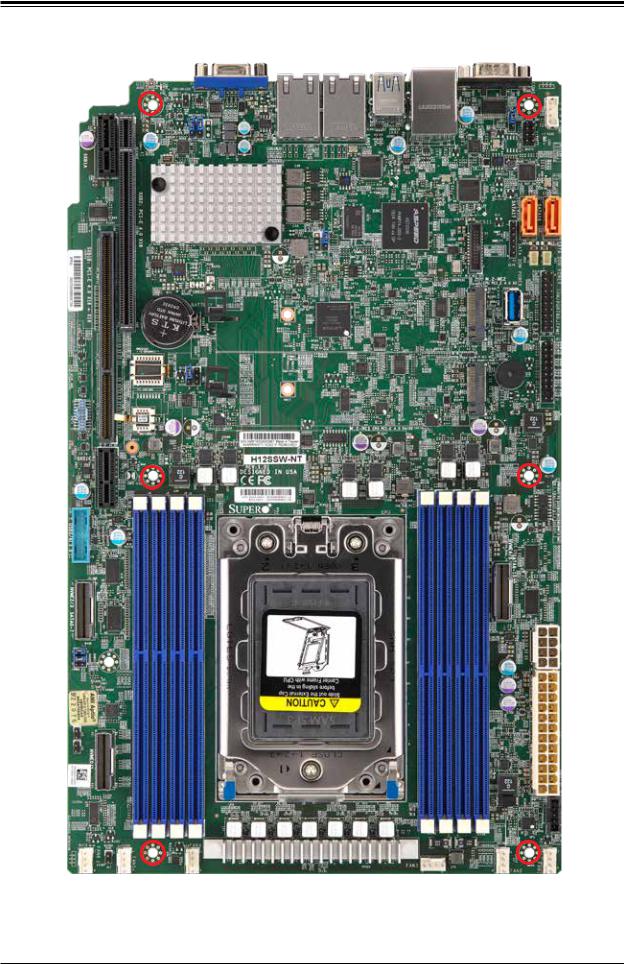
H12SSW-iN/NT Motherboard User's Manual
Figure 2-1. Motherboard Mounting Holes
22
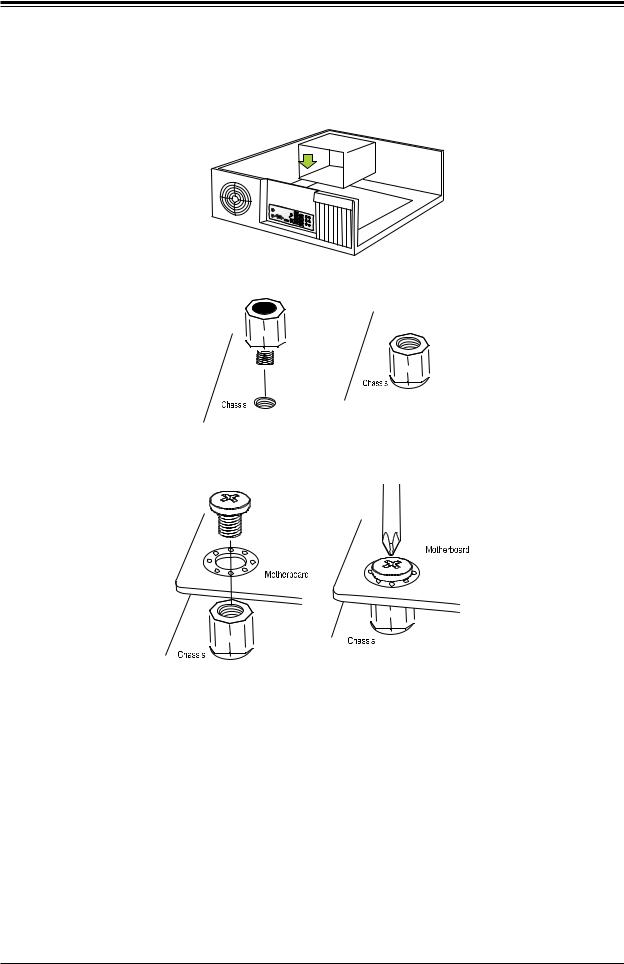
Chapter 2: Installation
Installing the Motherboard
1.Install the I/O shield into the back of the chassis.
2.Locate the mounting holes on the motherboard. See the previous page for the locations.
3.Locate the matching mounting holes on the chassis. Align the mounting holes on the motherboard with the mounting holes on the chassis.
4.Install standoffs in the chassis as needed.
5.Install the motherboard into the chassis carefully to avoid damaging other motherboard components.
6.Using the Phillips screwdriver, insert a Phillips head #6 screw into a mounting hole on the motherboard and its matching mounting hole on the chassis.
7.Repeat Step 5 to insert #6 screws into all mounting holes.
8.Make sure that the motherboard is securely placed in the chassis.
Note: Images displayed are for illustration only. Your chassis or components might look different from those shown in this manual.
23
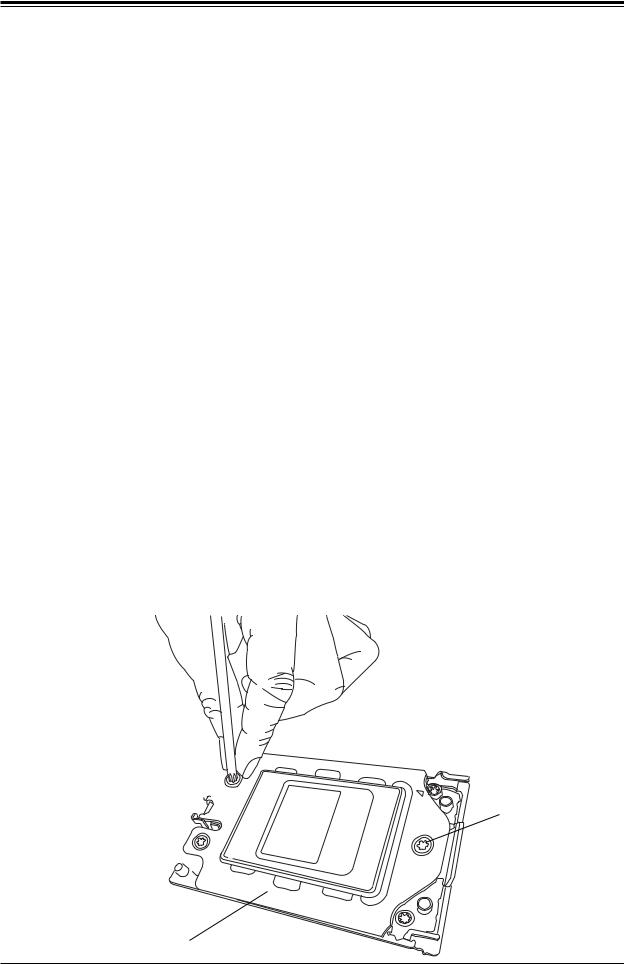
H12SSW-iN/NT Motherboard User's Manual
2.3 Processor and Heatsink Installation
Warning: When handling the processor package, avoid placing direct pressure on the label area of the fan.
Important:
•For the Processor/Heatsink installation you need to use a T20 screwdriver when opening/ closing the CPU socket.
•Always connect the power cord last, and always remove it before adding, removing or changing any hardware components. Make sure that you install the processor into the CPU socket before you install the CPU heatsink.
•If you buy a CPU separately, make sure that you use an AMD-certified heatsink only. Make sure to install the motherboard into the chassis before you install the CPU heatsink.
•When receiving a motherboard without a processor pre-installed, make sure that the plastic CPU socket cap is in place and none of the socket pins are bent; otherwise, contact your retailer immediately.
•Refer to the Supermicro website for updates on CPU support.
Installing the Processor and Heatsink
1.Unscrew the screws holding down Force Frame in the sequence of 3-2-1. The screws are numbered on the force frame next to each screw hole.
Screw #3
Screw #1
Screw #2
Force Frame
24
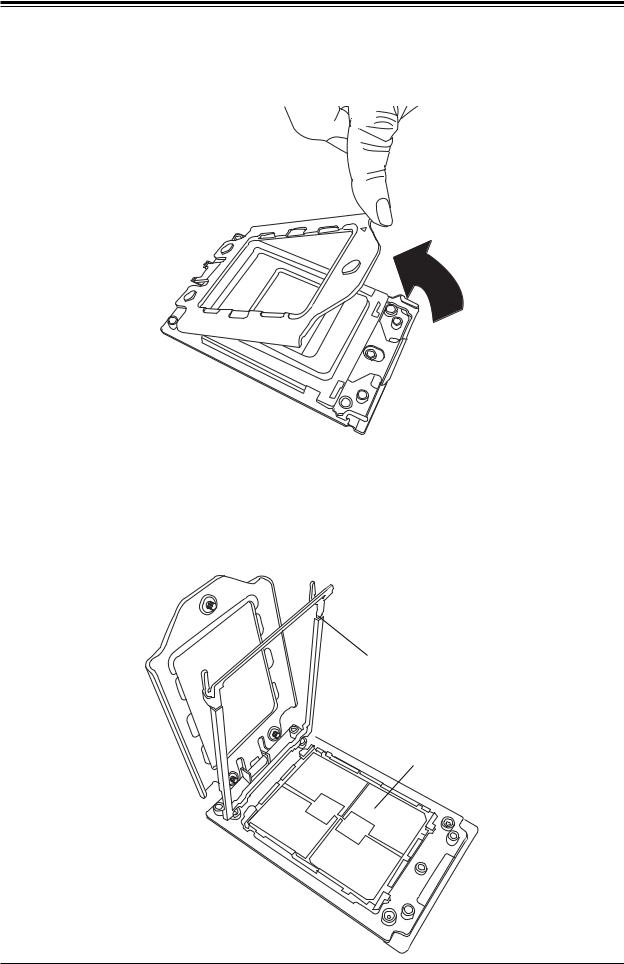
Chapter 2: Installation
2.The spring-loaded force frame will raise up after the last screw securing it (#1) is removed. Gently allow it to lift up to its stopping position.
3.Lift the rail frame up by gripping the lift tabs near the front end of the rail frame. While keeping a secure grip of the rail frame, lift it to a position so you can do the next step of removing the external cap.
Note: The rail frame is spring loaded, so keep a secure grip on it as you lift it so it does not snap up.
Rail Frame
PnP Cover Cap
25
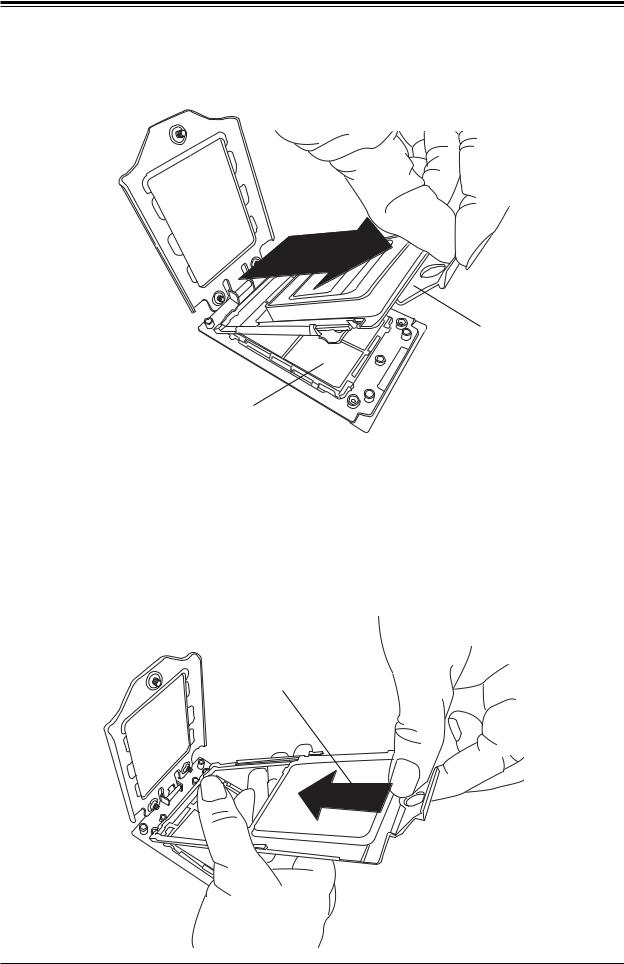
H12SSW-iN/NT Motherboard User's Manual
4.Remove the external cap from the Rail Frame by pulling it upwards through the rail guides on the rail frame.
External Cap
PnP Cover Cap
5.The CPU package is shipped from the factory with the blue carrier frame pre-assembled. Grip the handle of the carrier frame/CPU package assembly from its shipping tray, and while gripping the handle, align the flanges of the carrier frame onto the rails of the rail frame so its pins will be at the bottom when the rail frame is lowered later.
6.Slide the carrier frame/CPU package downwards to the bottom of the rail frame. Ensure the flanges are secure on the rails as you lower it downwards.
Carrier Frame/
CPU Package
26
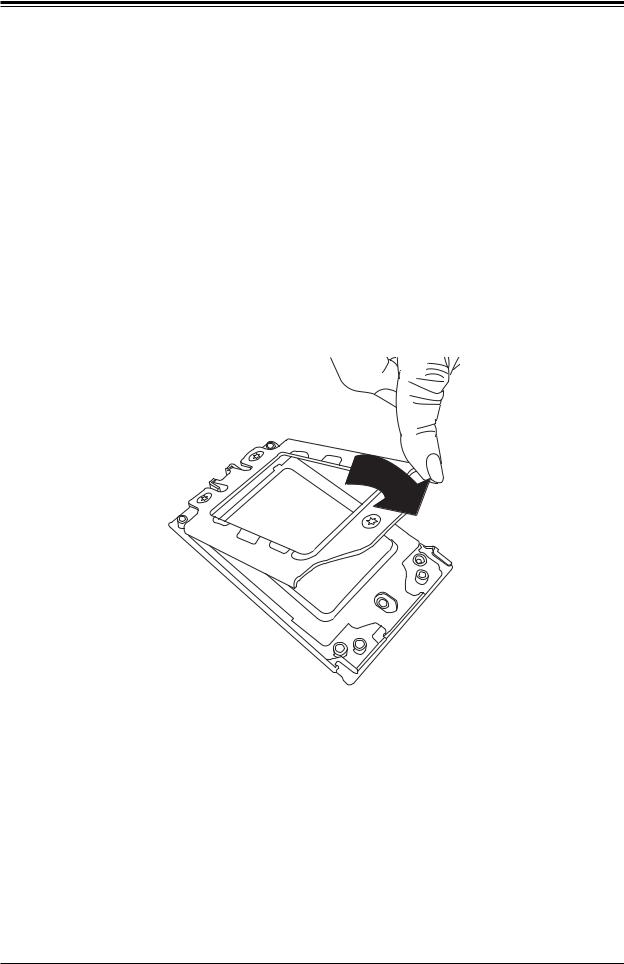
Chapter 2: Installation
Note: You can only install the CPU inside the socket in one direction with the handle at the top. Make sure that it is properly inserted into the CPU socket before closing the rail frame plate. If it doesn't close properly, do not force it as it may damage your CPU. Instead, open the rail frame plate again, and double-check that the CPU is aligned properly.
7.Lift up the rail frame till it securely rests in upright position. Then remove the PnP cover cap from the CPU socket below. Grip the two lift tabs marked "Remove" at the middle of the cap and pull vertically upwards to remove the PnP cover cap.
Warning! The exposed socket contacts are extremely vulnerable and can be damaged easily. Do not touch or drop objects onto the contacts and be careful removing the PnP cover cap and when placing the rail frame over the socket.
8.Gently lower the rail frame down onto the socket until the latches on the rail frame engage with the socket housing and it rests in place. DO NOT force it into place!
27

H12SSW-iN/NT Motherboard User's Manual
9.Gently lower the force frame down onto the rail frame and hold it in place until it is seated in the Socket housing. Note that the force frame is spring loaded and has to be held in place before it is secured. Important: Use a torque screwdriver, set it at 16.1 kgf-cm (14.0 lbf-in) with a Torx T20 screw head bit, to prevent damage to the CPU.
10. Place and re-screw the screws in the reverse order to the way you removed them
(holes 1-2-3 in order). When finished, the force frame will be secure over both the rail frame and CPU package.
28

Chapter 2: Installation
11.After the force frame is secured and the CPU package is in place, now you must install the heatsink to the frame. Lower the heatsink down till it rests securely over the four screw holes on CPU package on the socket frame.
12. Using a diagonal pattern, tighten the four screws down on the heatsink in a clockwise fashion till it is secure. The heatsink will now be secured and you have finished installing the processor and heatsink onto the motherboard. Repeat this procedure for any remaining CPU sockets on the motherboard.
#1 Screw
#3 Screw |
#4 Screw |
|
#2 Screw
29

H12SSW-iN/NT Motherboard User's Manual
Uninstalling the Processor and Heatsink
1.Remove the heatsink attached to the top of the CPU package by reversing the installation procedure.
2.Clean the Thermal grease left by the heatsink on the CPU package lid to limit the risk of it contaminating the CPU package land pads or contacts in the socket housing.
3.Reverse the procedure for installing the force frame onto the socket, unscrewing the plate in the 3-2-1 screw order and lift the force frame to the vertical position.
4.Lift the rail frame using the lift tabs near the front end of the rail frame. Note that the rail frame is spring loaded, so be careful lifting it up into a vertical position.
5.Grip the handle of the carrier frame and pull upwards to extract it from the rail frame. Return the carrier frame/CPU package to its original shipping container.
6.Grip the handle on the external cap and return it to the rail frame sliding it downwards till it rests in the frame.
7.Gripping the rail frame, rotate it downwards till it rests above and locks over the socket housing in its horizontal position.
8.Push and rotate down the force frame till it is over the external cap and rail frame into a horizontal position.
9.While holding down the force frame, secure it back to the socket frame by securing screw 1 in place. Note that without a CPU package in place, it is not necessary to tighten down screws 2 and 3 at this time.
30
